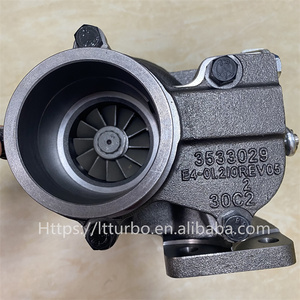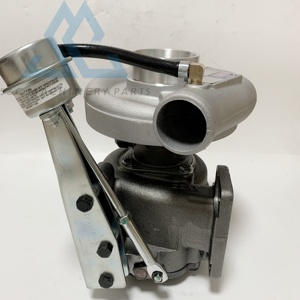(1709 products available)





































































































































































The turbo for Holset is a key part of the Holset turbocharger. Holset is a brand under Cummins Inc. that is popular for making turbochargers for heavy-duty and high-performance engines. The Holset turbo improves engine performance by forcing more air into the combustion chamber, resulting in a powerful engine. The Holset turbo has different types, including the following:
HX Series Turbocharger:
The HX turbo is one of the early Holset turbochargers. The Holset HX series turbo is known for its simple and reliable design. The HX series turbos charge small to medium-sized engines. The Holset HX series turbos charge small to medium-sized engines. The HX series turbos have the following:
Single-stage turbines and simple wastegate designs
HE Turbocharger:
The HE turbo is another early Holset turbo design. The Holset HE turbocharger is known for its robust construction and high-strength materials. The HE series turbos use a larger compressor wheel. This allows them to move more air and support a higher flow rate. Besides, the Holset HE series turbos have:
Multi-stage turbines and adjustable wastegate designs
HX-HE Turbo:
The HX-HE turbo combines the best features from the HX and HE series. The HX-HE turbos have a compact and lightweight design. They also incorporate advanced materials and manufacturing processes. The Holset HX-HE turbos also have:
Variable geometry turbines and electronic wastegate controllers
Q Series Turbocharger:
The Q-series is a modern Holset turbocharger. The Q-series turbochargers are designed to meet the demands of modern engines that comply with environmental regulations. The Q-series turbos also integrate advanced technologies, such as:
Variable turbine geometries, low-inertia turbine wheels, and integrated electronics
HE351VE Turbo:
The Holset HE351VE turbo is a variable geometry turbocharger for heavy-duty applications. The Holset HE351VE turbo is designed to optimize performance across a wide RPM range. The HE351VE turbo uses advanced materials, such as:
Aluminum for the compressor housing and titanium for the turbine components
1. Turbocharger Size and Model Number
Every Holset turbo has a model number that is based on the size of the turbo components. The turbo size and model number are used to select the right turbo for different applications and enable the replacement of parts as needed.
2. Engine Displacement/Size
The specified engine size for the turbo is based on. The engine size is used to match the turbo to the power requirements of the engine. A larger engine will require a larger turbo than a smaller engine.
3. Maximum Exhaust Flow (CFM)
The maximum amount of exhaust airflow that the turbo can handle is specified in cubic feet per minute. This value is important to ensure that the turbo is not overloaded with exhaust flow, which could damage the turbo over time.
4. Maximum Boost Pressure (PSI)
The maximum boost pressure that the turbo can produce is specified in pounds per square inch. This value must be monitored to prevent exceedance, as too much boost can lead to engine failure.
5. Compressor Inducer Diameter (Inches)
The diameter of the compressor wheel blades is specified, as this affects the airflow through the turbo. A larger compressor wheel results in increased airflow and boost pressure, while a smaller blade size will yield lower boost levels.
6. Turbine Exducer Diameter (Inches)
The turbine wheel blade size is specified. Like the compressor, turbine blade sizes impact the performance characteristics of the turbo.
7. Turbo A/R Ratio
The area-to-radius ratio of the turbo's compressor and turbine housings is specified. The A/R ratio affects how quickly the turbo spools up and the boost curve it produces.
8. Bearing Type
The type of bearings used in the turbo is specified, such as ball bearings or bushings. Ball bearings enable the turbo to spin at higher RPMs, leading to more boost production.
9. Wastegate Type and Actuator Pressure
The type of wastegate is specified, along with the pressure that the actuator operates at. This controls the amount of exhaust flow directed to the turbine and is critical in regulating boost levels.
10. Cooling Method
The method of cooling the compressed air from the turbo before it enters the engine is specified. Options include an air-to-water or air-to-oil cooler. Proper cooling increases engine power and efficiency.
Proper maintenance of Holset turbos is essential for optimal performance and longevity. The following are key maintenance requirements:
1. Clean Air and Oil Filters
Holset turbochargers rely on clean air and oil to function correctly and last. The air filters should be inspected and cleaned regularly according to the manufacturer's recommendations. Oil filters should also be replaced on schedule to ensure contaminants are removed before entering the turbo.
2. Engine Oil Changes
Fresh engine oil is critical for turbo longevity. Oil changes should be done at the recommended intervals or sooner if driving conditions require. This ensures the turbo is lubricated properly and protects against wear and damage. High-quality engine oil is also important. Holset turbos require premium grade oils for optimal performance. The use of lower quality oils may impact turbo function over time.
3. Check Oil Lines and Fittings
Oil leaks can be damaging to Holset turbos. All lines, hoses, and fittings should be inspected periodically for signs of dampness or oil pools around connections. Any leaks should be addressed immediately before causing major damage to the turbo. Loose fittings should also be tightened to prevent leaks from developing over time.
4. Inspect Cooling System Components
The cooling system components, such as hoses and clamps, should be examined regularly for proper function. Holset turbos require effective cooling to maintain optimal operating temperatures. Overheating due to cooling system failure can severely damage the turbocharger.
5. Visual Inspection of Turbo Components
A visual inspection of the turbo components should be carried out every so often. Any signs of wear or damage to the turbo housing, wastegate, actuator, or other parts should be noted. Problems should be addressed immediately to prevent worsening. Minor issues can often be fixed before major repairs are needed.
6. Turbo Warm-Up and Cool-Down Procedures
Proper warm-up and cool-down procedures are important for turbo health. Before driving, the turbo should be allowed to idle for a few minutes to circulate oil and reach optimal temps. After driving, the vehicle should idle for a few minutes as well. This gives time for the oil to coat the turbo components fully before shutdown. Skipping these steps can lead to turbocharger damage over time.
When buying a Holset turbo for resale, business buyers should consider these factors:
Model
Holset has several models of turbochargers, each designed for specific engines and applications. For example, the HX35W is suitable for a 5-liter diesel engine, while the HX50 is designed for larger 15-liter diesel engines. Stock and performance car owners will want to know the model of the turbocharger before buying. Therefore, buyers should stock various models to attract many customers.
Engine Size
Choosing the right turbocharger for an engine is critical for optimal performance. When reselling, buyers should research the engine sizes that most of Holset's turbocharger models pair well with. Stocking turbos that match the engine sizes of potential customers will make the business more profitable.
Condition
Both new and used Holset turbochargers are available on the market. Holset turbochargers are quite expensive, so many customers will opt for the more affordable used turbos. When buying used turbos, business owners should ensure they are in great condition and properly cleaned to meet customers' quality standards.
Application
Different models of Holset turbochargers are designed for different applications. Some are designed for heavy-duty use in trucks and industrial equipment, while others are more suited for light-duty use in passenger vehicles. Buyers should select turbos suitable for their target market. Holset turbochargers are primarily used in diesel engines. Therefore, buyers should target diesel vehicle owners.
Performance Level
Holset turbochargers are designed to give different performance levels. Some are high-performance turbos that can significantly increase a vehicle's horsepower. Resellers should evaluate the performance level of each turbo and match them to various Holset modification levels. Some of Holset's performance modification customers may want to upgrade their stock suspension to handle more torque. Therefore, buyers should also stock suitable suspension parts like coilovers and shocks.
Some common tools for working on turbochargers are socket sets, wrenches, pliers, screwdrivers, torque wrenches, oil filter wrench, hex key sets, and soft mallet. Holset turbo replacement can be a DIY project if the necessary skills and knowledge are possessed. Before replacing a turbo, the Holset turbocharger user manual should be referenced to ensure compatibility and correct installation. The tools and materials required for the specific turbo model should be gathered, including the new turbo, gaskets, and oil. Make sure the work area is clean and organized to avoid losing small parts or introducing contaminants into the engine. Disconnect the battery and drain the coolant. Remove the engine cover and intake pipe to access the turbo. Depending on the model, the exhaust downpipe may need to be removed to reach the turbo. Disconnect the oil feed and return lines. Remove the turbo mounting bolts and exhaust manifold nuts. Transfer the wastegate actuator and fittings, if applicable, to the new turbo. Lift the old turbo out and place the new turbo in. Holset 6 turbo bolts should be torqued to the manufacturer's specifications. Reconnect the oil lines, exhaust manifold, and downpipe. Reconnect the intake pipe and replace the engine cover. Refill the coolant and reconnect the battery. Start the engine and let it idle to ensure there are no leaks and the turbo is functioning correctly. Double-check all connections and fittings to ensure everything is properly installed and there are no leaks before driving the vehicle.
Q1: What is the Holset Turbo?
A1: The Holset turbo is a turbocharger that uses the Holset engine. The Holset turbo is not a turbocharger but a Holset turbo. It is a turbocharger brand. Holset is a well-known and trusted brand in the turbocharger industry. Holset focuses on producing high-quality turbochargers for commercial vehicles, especially for diesel engines.
Q2: Who makes the Holset turbo?
A2: Holset is a Cummins-owned brand. Holset is a subsidiary of Cummins Inc., a manufacturer of engine components and power generation equipment based in the United States. Holset turbochargers are widely used in Cummins engines, but they can also be used in non-Cummins engines, especially diesel engines.
Q3: Are Holset turbos good?
A3: Yes. Holset turbochargers are high-quality turbochargers for diesel engines. They are designed for high performance, durability, and reliability. Holset turbochargers are mainly used for commercial vehicles, heavy-duty trucks, and buses. Holset turbochargers can handle high loads and provide consistent and efficient boost. As a result, the Holset turbocharger is a popular choice for upgrade and replacement.
Q4: Can I use the Holset turbo on a gasoline engine?
A4: Holset turbochargers are mainly designed for diesel engines. However, it can also be used in gasoline engines. The Holset turbo is suitable for high-performance applications and can be used for engine modifications to increase power and efficiency.